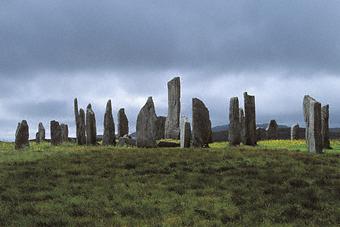| Region : | Western Isles | |
|
| Island : | Lewis (Leòdhas) | ||
| Town or village : | Callanish (Calanais) | ||
| Grid Reference : | NB 213 330 | ||
| Period : | 2200-1700 BC | ||
(Tursachan Calanais)
MEGALITHIC COMPLEX
 |
|
The ring, flattened to the east, comprises 13 stones up to 3.5m in height and is 13m x 11m in diameter. The central monolith is 4.75m high and only 30cm thick. Between the central pillar and the eastern stones of the ring lies a small chambered tomb, revealed in 1857 when the peat was stripped away. The cairn is some 7m in diameter and it is probably a later addition to the site. In the two compartment chamber only fragments of cremated human bones were found.
Three stone rows and an avenue project from the circle, as the limbs of a cross. The avenue (the longest limb), consisting of two rows of 9 and 10 surviving stones, extends to the north for 82m. The three stone rows (the shortest limbs) are roughly aligned to the other three cardinal points. They consist of 4 or 5 stones each. The easternmost stone of the east row, present in 1857 and then lost, was discovered in 1977 beneath the turf by Margaret Curtis and Gerald Ponting and re-erected in its original socket in 1982. Excavations in the '70s revealed that the site had been erected on previously cultivated land.
Callanish has astronomical significance, especially in relation to the movements of the moon. Aubrey Burl in his Circles of Stone. The Prehistoric Rings of Britain and Ireland, writes that it was the famous Greek historian Diodorus Siculus, who died some time after 21 BC, who first provided an astronomical explanation of the site: "He wrote of a 'spherical temple', presumably in Britain. This has been taken to refer to Stonehenge. It does not. The statement that 'the moon as viewed from this island appears to be but a little distance from the earth' refers to something impossible at the latitude of Stonehenge, but exactly describes what the southern moon does at Callanish, where it seems to roll along the top of the skyline".
There are several legends about Callanish. One tells that the stones were giants assembled in a council and turned into stone by St Kieran. According to another legend, cuckoos reaching Lewis in the spring are supposed to fly to Callanish and give their first call from there.
From the megalithic complex two other smaller stone circles, Callanish II and Callanish III can be seen to the east.
In care of Historic Scotland